You are currently viewing a course sample, but you’re not yet a member! Only certain modules will be available to you. To sign up for a membership to access the full course, check out our Plans and Pricing or Login
Can You Hear Me Now?
One of the most visible (and certainly most audible) parts of a sound system are the loudspeakers. Loudspeakers take electrical signals sent to them and convert them into acoustical energy (sound waves). They are an incredibly important part of any sound system because they are the final piece before the sound hits your eardrums.
Loudspeakers come in a variety of shapes and sizes. Here we’ll address the most common types as well as define some common terms relating to loudspeakers and their specifications. We’ll dig into advanced loudspeaker setups in later modules, but this will help ensure we’re all on the same page. We’ll also cover many of the most common terms when talking about loudspeakers to give you a good foundation to build on.
Active vs. Passive:
Although we talked briefly about this when we broke down the individual components in a sounds system, it’s worth reiterating. There are fundamentally two different types of loudspeaker systems. Active speakers have an amplifier built right in. Active loudspeakers require some sort of power and a line or mic level signal. The low level signal is then converted to speaker level signal within the attached amplifier and played back out of the speaker. Active speakers used to be a rarity in sound systems, but as amplifiers become smaller and more powerful, more and more systems are beginning to use active speakers. Active speakers are generally heavier, but they are convenient because you don’t have to carry around racks of additional amplifiers to drive the speaker boxes.
Passive speakers do not require an external power supply, but they do need a speaker level signal. This means you have to have another amplifier somewhere else in the chain. Passive speakers are more common than active speakers and are usually easier to setup, although the speaker cables tend to be heavy and expensive compared to typical line level cables. If your speaker does not need to plug into external power, it is likely a passive speaker. When using passive speakers, you’ll also need to carry amplifiers. On small systems these can actually be embedded directly in the mixing console, but by far the most common place is in an external stage rack. You’ll also need to carry enough heavy-gauge speaker cable to easily get from your amplifier to your speakers.
Understanding A Speaker:
As we mentioned, a speaker’s job is to convert electrical signals into acoustic energy. The mechanism that does this in the speaker is called the driver. Most speakers have multiple drivers that are broken up by frequency. Two-way speakers have a low frequency driver and a high frequency driver. Three-way speakers have a low frequency driver, a mid-range driver, and a high frequency driver. Within each speaker there is an electrical device called crossover that takes a single input and divides it instantly into the appropriate frequencies to send to each driver.
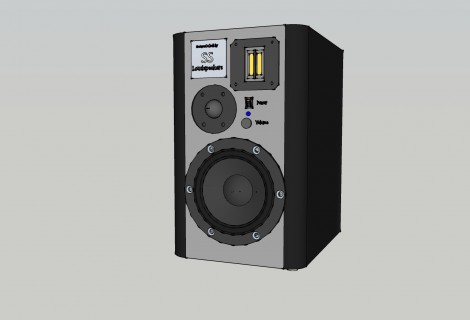
This is a 3D illustration of a 3-way system. It has a low frequency driver (the largest speaker cone), a mid frequency driver (the middle circle), and a tweeter (the gold square in the top right).
Most speakers systems are at least two way systems (with a low and high frequency driver in each loudspeaker). Many pro-level systems can be three-way (or even four-way) systems. These systems simply add in low-mid and high-mid drivers. One system isn’t inherently any better than the other, although sometimes having more drivers allows each driver to “specialize” in a few certain frequencies. These systems often sound better, but there are no guarantees. There are some awesome sounding systems that only have a high and low driver.
Crossovers
Crossovers take the electrical signal and split it between the drivers. Low frequencies go to the low frequency driver while high frequencies are sent to the high frequency driver (duh!). In most small systems, the crossover is built into the speaker box and you never need to change or adjust it. If the system is passive, the crossover is designed to handle the speaker level inputs and separate each of the frequencies. In an active system, the crossover is still built into the box, but is often between the internal amp and the drivers. Most boxes are tuned so the crossover falls at the exact frequency where it needs to separate the signals.
The frequency where the crossover divides the signal (or “crosses over” the signal) is called the crossover point. Each and every driver has a specific frequency where it should be crossed over in order to maximize the potential energy of the speaker. If you send frequencies to a driver that it is not intended to produce, you can damage your system.
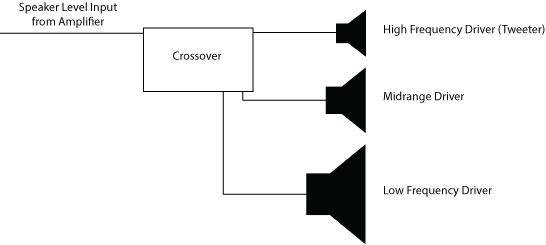
This is a passive three-way speaker system. The crossover divides the signal into certain frequencies that are then sent to the appropriate drivers.
Although you may not be required to understand how a crossover works on your system, it is important to note that they are an important part of virtually every sound system designed to reproduce the full frequency spectrum. They are working even though you might not even be aware that they exist.
Turn up the bass!!! Understanding the Low-Frequency Driver:
When most people think of speakers, they tend to think of the low-frequency driver portion of the speaker. These low frequency drivers are usually cone shaped and made of some sort of paper, polymer, plastic, or carbon. Because low frequencies have longer wavelengths, they take much more energy to generate. Good low frequency drivers typically have a large surface area (meaning that they are large) and they also have a long diaphragm excursion. This means that the actual part of the cone that moves back and forth can move back and forth over a large distance.
Although low frequency drivers get all the attention, the other drivers are just as important for getting a nice, full sound.
Mid-Frequency Drivers:
Typically mid frequency drivers are smaller, specialized versions of the low frequency drivers. They do not need the same surface area or excursion depth of a typical low frequency driver. In a four way system, you may have two mid-frequency drivers – each covering a different frequency range. Mid-frequency drivers use the exact same principles of their low or high frequency drivers, but they are just tuned to frequencies not covered by either of the other drivers.
High-Frequency Drivers (Tweeters):
In most current pro audio systems, the high frequency drivers are shaped like horns and use compression drivers. Good compression drivers do not need the same amount of physical space since high frequencies have much shorter wavelengths. High frequency drivers are often called “tweeters”. By far the most common type of high frequency driver in most speakers is called the compression driver. Compression drivers work in conjunction with the horn shaped enclosure they are placed in to create the audible high frequencies you hear. Although the technical details of compression drivers are beyond the scope of this module, you can read more about them on Wikipedia.
A less common type of high frequency driver is the ribbon driver. The ultralight weight of the ribbon allows it to move quickly making it able to respond quickly to changes in music. Ribbon drivers are generally considered to sound “smoother” than compression drivers, but they are fragile and more expensive so they aren’t used as often in professional sound reinforcement. They are far more common in recording studio monitors or high-end home theater systems.
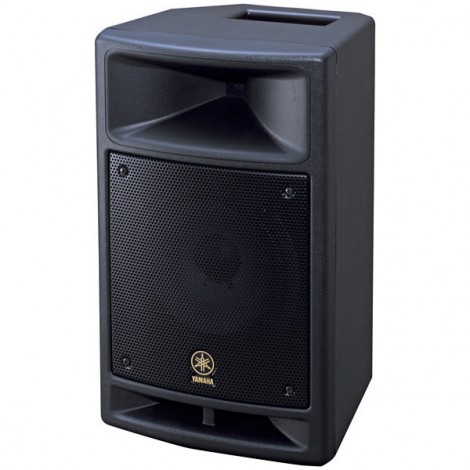
Image courtesy of Yamaha USA
Coverage Patterns:
Much like microphones, speakers have distinct coverage patterns. Speaker coverage plots also use a circular graph to illustrate coverage.
Although these charts look intimidating, they are really quite simple once you get the hang out analyzing them. Let’s break one down.
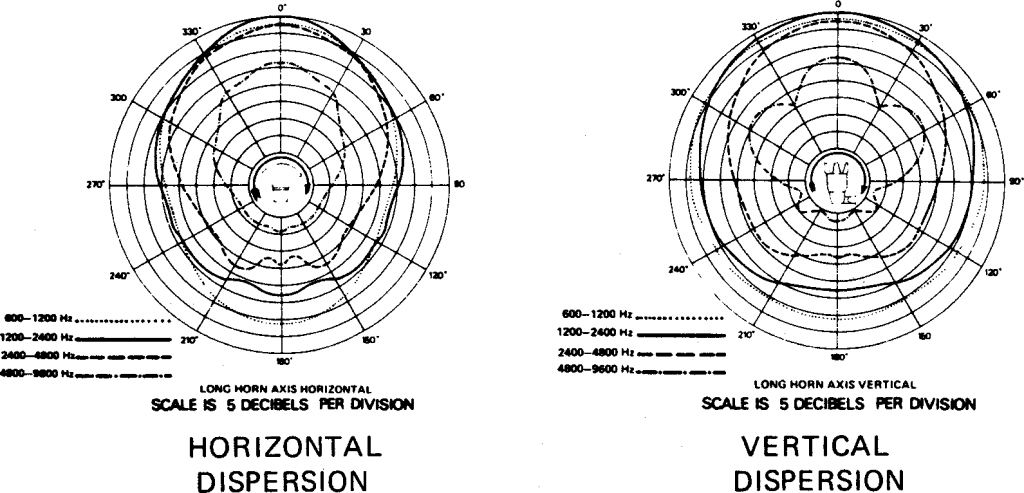
Image Courtesy of ElectroVoice
Let’s break down this image to figure out what it’s telling us.
First, let’s look at what the text is telling us.
The legend tell us that each type of line is a different frequency. The line with the smallest dots is are the frequencies in the 600-1200 Hz range. The solid line are the frequencies from 1200-2400 Hz and so on.

When you look at the actual image, you see several sets of odd looking shapes. It might be intimidating at first, but we’ll break it down so it’s simple to understand.
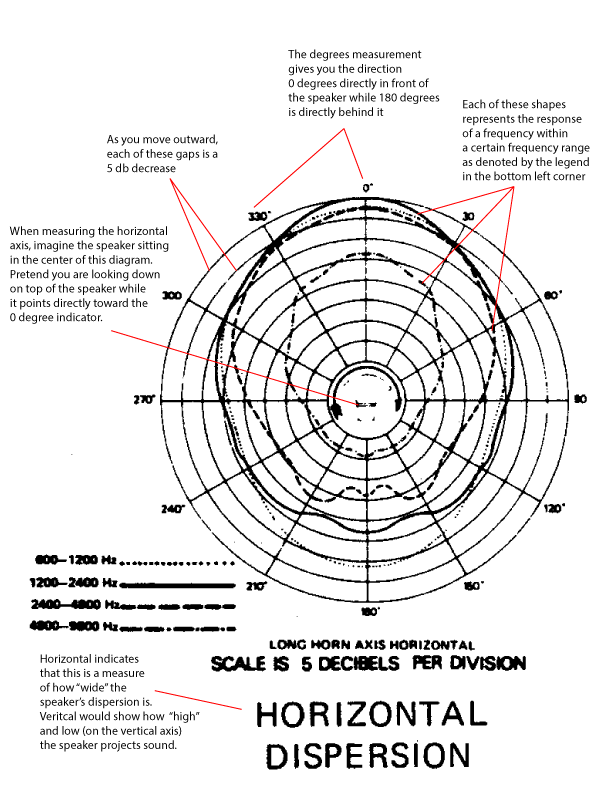
Got it? Although it may seem a little theoretical at this moment, all this knowledge will become helpful when we actually begin setting up a sound system. Next we’ll dig into some of the specs behind your typical loudspeaker so you know what your system is capable of handling.
[kkstarratings]